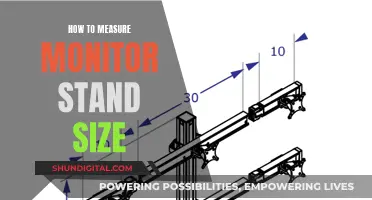
There are many factors to consider when buying a monitor, such as the type of display, key features, specs, and budget. The best monitor for you will depend on how you plan to use it. For example, if you're a gamer, you'll want a monitor with a high refresh rate and response time, while a creative professional will prioritize color accuracy and display resolution. It's also important to consider the size of the monitor and whether it has features like built-in speakers or USB ports. With so many options available, it's easy to find a monitor that fits your specific needs and budget.
| Characteristics | Values |
|---|---|
| Monitor type | TN, IPS, VA, OLED, QLED |
| Monitor size | 24", 27", 32", 34", 49" |
| Resolution | 1080p, 1440p, 4K, 5K, 8K |
| Refresh rate | 60Hz, 120Hz, 144Hz, 160Hz, 180Hz, 240Hz, 360Hz, 480Hz, 500Hz |
| Response time | 2ms, 3ms, 5ms, 12ms |
| Brightness | 250 cd/m2, 350 cd/m2, 400 cd/m2, 450 cd/m2 |
| Contrast ratio | 1,000:1, 3,000:1, 4,209:1, 12,000:1, 25,000:1, 1,000,000:1 |
| Ports | HDMI, DisplayPort, DVI, VGA, USB-C, USB-A, USB 3.0 |
| Stand | Fixed, adjustable, VESA-compatible |
| HDR | Yes, No |
| Speakers | Yes, No |
What You'll Learn

Monitor resolution and its impact on image quality
Monitor resolution is a crucial factor when purchasing a new monitor, as it will significantly influence your viewing experience, especially when working with photos and graphics. The resolution refers to the number of pixels displayed on a screen, measured in horizontal and vertical pixels. The higher the resolution, the more pixels are present on the screen, resulting in a higher quality and more detailed image.
For instance, a Full HD 1080p resolution monitor has a resolution of 1920 x 1080 pixels, with a width of 1,920 pixels and a height of 1,080 pixels, resulting in a total of 2,073,600 pixels on the screen. This resolution is suitable for 24-inch monitors but may lack sharpness on larger displays. On the other hand, a 27-inch or 32-inch monitor with a resolution of 2560 x 1440 (1440p) or higher will provide a sharper image and enhanced viewing experience.
The impact of monitor resolution on image quality is evident when comparing different resolutions on the same screen size. For example, a 27-inch monitor with a 1080p resolution will have a lower pixel density than a 27-inch monitor with a 1440p resolution. The higher pixel density results in smoother lines, sharper images, and more detailed visuals. This is because there are more pixels packed into every square inch of the screen, improving the overall image quality.
Additionally, the type of panel used in the monitor also affects image quality. In-Plane Switching (IPS) panels offer wide viewing angles, crisp images, and good colour accuracy, making them ideal for professional photographers and graphic designers. Vertical Alignment (VA) panels provide excellent contrast and image depth, improving overall image quality, especially in movies and TV shows. Twisted Nematic (TN) panels are commonly used in gaming monitors due to their fast refresh rates but may lack colour accuracy.
When choosing a monitor, it is essential to consider the intended use. For multimedia professionals, a larger screen with a resolution of at least Full HD or Quad HD is recommended for detailed images. Gamers should opt for a monitor with a resolution of at least Full HD, a fast response time, and a refresh rate of 60Hz or higher. For everyday tasks, such as web browsing or social media, a lower-priced monitor with a smaller screen and Full HD resolution is sufficient.
Warning Signs: Is Someone Monitoring Your Internet Activity?
You may want to see also

Monitor size and how it affects your viewing experience
Monitor size is a crucial factor when buying a monitor, as it directly affects your viewing experience and comfort. The size of a monitor is typically measured diagonally from one corner to the opposite corner and is represented in inches. While bigger screens offer more screen real estate, it's important to consider your available space, viewing distance, and resolution to find the optimal monitor size for your needs.
The relationship between screen size and viewing distance is crucial for achieving an optimal viewing experience. If you sit too close to a large screen, you may experience pixelation and eye strain, while sitting too far from a small screen can make it difficult to appreciate the details and resolution. The key is to find a balance where the screen size and viewing distance complement each other, providing a comfortable and immersive experience.
For example, if you're looking for a 1080p monitor, the optimal viewing distance is approximately 1.5 to 2.5 times the screen size. So, for a 24-inch monitor, the ideal viewing distance is between 36 and 60 inches (3 to 5 feet). On the other hand, if you're considering a 4K monitor, the optimal viewing distance is closer, at approximately 1 to 1.5 times the screen size. For instance, for a 27-inch 4K monitor, the ideal viewing distance is about 2.5 to 4 feet.
Additionally, the aspect ratio of the monitor also comes into play. Common aspect ratios include 16:9 (widescreen) and 4:3 (standard), which influence the screen's shape and viewing experience. The aspect ratio affects the overall dimensions of the screen and how content is displayed. For instance, a widescreen monitor is great for video content but may not be as well-suited for scrolling through documents.
When deciding on a monitor size, it's essential to consider your intended use. If you're a gamer or multimedia professional, you may require a larger screen to fully appreciate the visuals and details. However, if you're mainly using the monitor for everyday tasks like email, web browsing, or office work, an average-sized monitor (around 23 to 24 inches) with Full HD resolution may be more than sufficient and offer a more comfortable viewing experience.
G-Sync Monitor: Does the Asus G751J Support It?
You may want to see also

Refresh rates and their role in performance
The refresh rate of a monitor is the number of times it can update its display per second, and it is measured in hertz (Hz). The higher the refresh rate, the smoother the visual quality. The standard refresh rate for most monitors is 60Hz, but more specialized, high-performance monitors can support 120Hz, 144Hz, 240Hz, or even 360Hz.
The benefits of higher refresh rates are most noticeable in gaming, where a high refresh rate can make a significant difference in the gaming experience, especially in fast-paced, competitive games. A higher refresh rate reduces motion blur and input lag, resulting in smoother visuals and a more responsive gaming experience. For example, a 144Hz monitor will offer a smoother and more responsive gaming experience than a 60Hz monitor.
However, simply buying a high refresh rate monitor does not guarantee improved performance. The monitor's refresh rate must be supported by the computer's hardware, including the CPU, GPU, and frame rate. If the computer cannot supply frames at a rate that matches the monitor's refresh rate, the benefits of the higher refresh rate will not be realized.
For non-gaming use, such as office work or browsing the web, a standard 60Hz refresh rate is generally sufficient. However, for more visual professions like creative production, game development, and video editing, a higher refresh rate can be beneficial. It provides smoother content viewing and improves the overall viewing experience, especially when dealing with demanding visual processing tasks.
When choosing a monitor, it is important to consider the intended use and ensure that the refresh rate, along with other specifications, meets the requirements of those tasks. For gaming and multimedia professionals, a higher refresh rate of 120Hz or above is recommended, while for general-purpose use, a 60Hz refresh rate is usually adequate.
Easy Guide: Setting Up Powered Monitors for Beginners
You may want to see also

Panel types and their unique strengths and weaknesses
There are three main types of monitor panels: TN (Twisted Nematic), IPS (In-Plane Switching), and VA (Vertical Alignment). Each has its own unique characteristics, strengths, and weaknesses.
TN Panels
TN panels are the most common and affordable type of monitor on the market. They offer a fast response time (typically 1ms), making them suitable for gaming and watching action-packed movies. However, they often have poor colour accuracy and narrow viewing angles, which can cause distortion when viewed from an angle. TN panels are ideal for those seeking a fast response time and don't mind compromising on image quality.
IPS Panels
IPS panels are known for their wide viewing angles and accurate colour reproduction. They tend to have slower response times than TN panels (around 4ms), which may result in motion blur during fast-paced games or movies. IPS monitors are ideal for graphic designers, photographers, and anyone who prioritises image quality over response time. They tend to be more expensive than TN panels but offer improved colour accuracy and viewing angles.
VA Panels
VA panels offer high contrast ratios and deep blacks, making them excellent for watching movies and other media requiring deep blacks. They have slower response times than TN panels (around 5ms) and may suffer from colour shifting when viewed at extreme angles. VA panels are ideal for those who want improved image quality without the high cost of IPS panels.
OLED Panels
OLED panels are a different type of display that doesn't rely on a backlight. They offer superior contrast, wider viewing angles, and better energy efficiency than traditional LCD monitors. However, they tend to be more expensive and can suffer from burn-in if a static image is displayed for long periods. OLED panels are ideal for those who prioritise image quality and are willing to pay a premium.
LCD Panels
LCD (Liquid Crystal Display) panels are the most common type of display, offering decent image quality and affordable prices. They are often used in monitors, laptops, and TVs. LCD panels have poor viewing angles and lower contrast ratios compared to other display types but are excellent for budget-conscious buyers and gamers who want fast refresh rates and low input lag.
Mini-LED and Micro-LED Panels
Mini-LED and Micro-LED panels are newer display technologies that offer improved contrast, brightness, and energy efficiency compared to traditional LCD panels. Mini-LED panels are often used in high-end gaming monitors and TVs, while Micro-LED panels are still relatively new and not widely available.
Asus Portable Monitors: Compatible Partners for MacBook Pro 13?
You may want to see also

Additional features to enhance your user experience
There are several additional features you may want to consider when buying a monitor to enhance your user experience. Here are some key features to look out for:
- Built-in Speakers: Not all monitors have built-in speakers, so if you plan to use your monitor for video calls, watching videos, or listening to music, ensure your monitor has this feature or plan to purchase separate speakers.
- Webcam: If you frequently participate in video chats or video conferences, consider a monitor with a built-in webcam for added convenience.
- USB Ports: USB ports allow you to connect peripherals such as mice, keyboards, or other devices directly to your monitor. This can be useful if your computer has limited ports or if you want easy access for connecting devices.
- Adjustability: Look for a monitor with adjustable features such as height, tilt, swivel, and pivot adjustments. This will allow you to find the most comfortable viewing angle and orientation for your needs.
- Dual-Monitor Stands: If you plan to use multiple monitors, consider investing in a dual-monitor stand. This lets you dock two monitors on one stand, providing a seamless experience for multitasking or viewing spreadsheets side by side.
- VESA Compliance: If you plan to mount your monitor to a desk or wall, ensure it is VESA compliant. This means the monitor has an industry-standard hole pattern for mounting and will be compatible with most mounting solutions.
- High Dynamic Range (HDR): HDR technology delivers better contrast, improved colour accuracy, and more vibrant colours. It enhances your viewing experience, making it ideal for movies, games, and content creation.
- Blue Light Reduction: Monitors with blue light reduction features allow you to decrease the amount of blue light emitted from the display, providing a more relaxing and less stimulating viewing experience.
- Adaptive Sync: If you're a gamer, consider a monitor with Adaptive Sync technology. It synchronizes the refresh rate between the GPU and the display, eliminating screen tearing and providing a smoother gaming experience.
Cleaning Your LCD Monitor: A Step-by-Step Guide
You may want to see also
Frequently asked questions
There are four main types of monitors: TN, IPS, VA, and OLED. TN panels are the fastest and cheapest but have weaker viewing angles. IPS displays have slightly slower response times but better colour than VA monitors. VA monitors have the best contrast, and OLED monitors are the most colourful but also the most expensive.
Monitors typically range from 21 to 24 inches for 1080p resolution, and 27 to 32 inches for 1440p resolution. 4K monitors usually start at 32 inches. A larger monitor can improve productivity, but it will also be more expensive and take up more space.
The most common resolution is 1080p (1920 x 1080), but 1440p (2560 x 1440) is recommended for 27-inch and 32-inch monitors. 4K (3840 x 2160) is ideal for larger monitors and offers a great upgrade for 27-inch and 32-inch monitors.
A monitor's refresh rate is the number of times it updates with new information per second, measured in hertz (Hz). A higher refresh rate means a smoother image. Most monitors have a 60Hz refresh rate, but gamers should look for a monitor with at least 120Hz or 144Hz.
Some features to consider when buying a monitor include built-in speakers, headphone jacks, USB ports, height and tilt adjustment, and VESA compliance for mounting.







